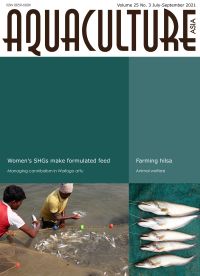Some facts on cannibalism in Wallago attu and its management during captive seed production
29 September 2021 | 1568 Downloads | .pdf | 1004.63 KB | Freshwater finfish, Hatchery and nursery, Nutrition and feeding, India
Wallago attu is a large catfish reaching 45 kg found in the Indian subcontinent, Thailand, Vietnam, Cambodia and Indonesia. It is an excellent food fish due to high nutritional quality and softness of flesh, and lack of intramuscular spines. It is only available in the market occasionally, due to the decline of wild populations.
Early attempts at captive production encountered high losses due to cannibalism during early life stages. W. attu is known to be a highly predatory fish. This article discusses the causative factors governing cannibalism in this catfish, including rapid transfer from live to commercial feed, size differences during stocking, seasonal changes, feeding at long intervals, high density rearing, feed distribution, feeding method and size of feed, and management strategies for minimising losses during the seed rearing period.
Creative Commons Attribution.

